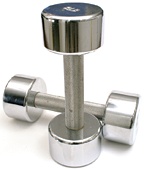Every parent hopes for positive experiences for their child, and some might even harbor dreams that their child is the next Tiger Woods or Tom Brady. The world's next young superstars are competing all over the globe and they are looking to their parents for guidance. It's up to us as parents and coaches to make sure our kids are safe, well-equipped both physically and mentally, and emotionally capable to handle whatever life throws their way. Preparing them athletically can set the stage for even greater successes later in life.
Strength Training
According to the Mayo Clinic, as early as age 8, kids can begin to benefit from a properly supervised strength training program. Strength training can increase your child's muscle strength and endurance; help protect their muscles and joints from injury; strengthen their bones; help promote healthy blood pressure and cholesterol levels; boost their metabolism; help them maintain a healthy weight; improve their self-esteem; and improve their performance in almost any sport, from dancing to football. When developing a program for your child, parents should:
- Seek instruction from a coach or personal trainer with youth strength training experience.
- Warm up each session with 5-10 minutes of light aerobic activity.
- Keep it light with one set of 12-15 repetitions with small weights, bands or just using the child's own body weight.
- Stress proper technique and supervise the child at all times.
- Rest between workouts by allowing at least one full day between exercising each specific muscle group. Two or three sessions per week are plenty.
- Keep it fun for your child so they don't get bored.
 Weight Training Do's and Don'ts
Weight Training Do's and Don'ts
According to the Mayo Clinic, the following tips can help your child maximize their weight training program and reduce the risk of injury.
Do Have Your Child:
- Lift an appropriate amount of weight by starting with a weight they can comfortably lift 12-15 times. Gradually increase the amount of weight as they get stronger.
- Use proper form because the better their form, the better their results.
- Breathe. Young athletes might have a tendency to hold their breath while they lift weights. This can lead to dangerous increases in blood pressure.
- Seek balance by working all of the major muscle groups.
- Rest by avoiding exercising the same muscles two days in a row.
Don't Have Your Child:
-
 Skip their warm-up because cold muscles are more prone to injury.
Skip their warm-up because cold muscles are more prone to injury. - Rush. Taking it slow helps to isolate muscles and keeps them from relying on momentum to lift the weight.
- Overdo it because this might cause injury.
- Work through the pain. If an exercise causes pain, stop immediately.
National Youth Sports Foundation Safety Quiz
How safe are children's sports activities in your community? The following questions address several key safety issues. See how your community stacks up.
- Are coaches certified in sports first aid and CPR? This includes coaches involved in school sports as well as volunteer coaches who run youth leagues.
- Are the coaches certified by either the national governing body of their sport, American Red Cross Sports Safety Training Program, National Youth Sports Coaches Association, American Sport Education Program or PACE?
- Are background checks done on coaches before they are hired?
- Does the coach have a written emergency plan in case of an accident, and has it been rehearsed?
- Is there a first aid box and ice at the site of all the practices and games?
- Does the coach have the youngsters do warm-ups, stretching and cooldown exercises?
- Does the coach hand out a conditioning program before sign-ups so the children know what is to be expected of them physically?
- Does your town have a sports injury prevention course for students as part of their health education program?
- Are pre-participation physical exams required for sports activities?
- Are the facilities checked for safety on a regular basis?
- Is safety equipment available or required? If yes, does it fit properly? Does it meet national standards? Is it in good condition?
- Does the team have a sports parent code of conduct?
- Does the team have a preseason meeting for parents outlining the program philosophy and safety procedures?


